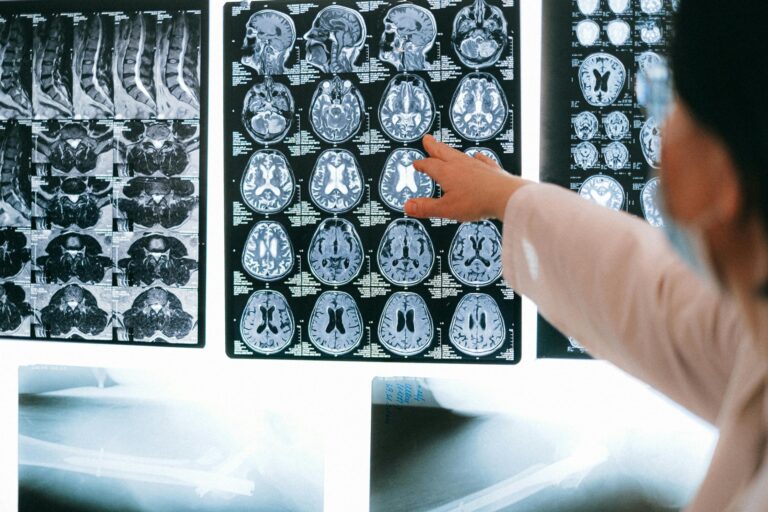Meet Dr. Kyle Fargen. He is a neurosurgeonMedical doctor who diagnoses and treats surgical issues related to the brain, spine, and nervous system. Click the term to read more at Wake Forest University and author of Idiopathic Intracranial Hypertension Explained: A Guide for Patients and Families. He has had an interest in IIH since his residency and has published many articles on it. His most recent publication, Intracranial Venous Hypertension and Venous Sinus Stenting in the Modern Management of Idiopathic Intracranial Hypertension, has shown that a neurosurgical intervention can help resolve IIH in select patients.
We had the opportunity to get to know Dr. Fargen, how he developed an interest in idiopathicThe term idiopathic is used when there is no detectable reason for something. Click the term to read more intracranial hypertension, and some helpful advice on how providers can help patients.
What led you towards an interest in treating patients with IIH?
My interest in IIH began during my first real exposure to venous sinus stentingA minimally invasive surgery during which a metallic mesh in the shape of a tube (stent) is placed in the sinus. Click the term to read more as a resident physician in neurosurgery. The case was so dramatic and interesting that we actually published it as a case report. A patient with IIH presented with very high intracranial pressures and papilledemaSwelling of the optic nerve that carries visual signals from the eye to the brain. Click the term to read more which progressed to coma. We performed a ventriculoperitoneal shuntA procedure undertaken to prevent accumulation of excess cerebrospinal fluid in the brain Click the term to read more surgery however she did not improve. An intracranial pressure monitor was then placed and the patient continued to have severely elevated intracranial pressures even with the shuntA hollow tube that can be surgically placed in the sinus to help drain cerebrospinal fluid. Click the term to read more in place. Imaging showed severe transverse sinus stenosis. Very few people were stenting for IIH at that time, much less in the setting of severe symptoms and a recent shunt surgery. We subsequently performed transverse sinus stenting, while the intracranial pressure monitor was in place, and watched the pressures drop immediately from the 60’s to 20 once the stent was deployed. The patient woke up from her coma and papilledema disappeared. It was incredible!
As a junior attending physician, I started performing my own venous sinus stenting cases and became fascinated with the disease process and physiology. It became very apparent that we, as doctors, actually knew very little about why vein narrowing was occurring in this condition, what was affecting the venous pressures we were measuring, and what was happening after we were stenting. Even now there are many things we do not understand. This fascination has kept me motivated to persevere while dealing with this challenging condition, which tends to take its toll on patients and providers.
What’s your current research focus in IIH?
My current research focus centers around understanding the ‘why’ of IIH. Animal studies and recent work we have done suggests that high intracranial venous pressures are the culprit and are driving the fluid pressure around the brain to be high. This high venous pressure is often made even higher by mysterious vein narrowing that seems to be instigated as a result of high fluid pressure. Our work focuses on trying to define what normal cerebral venous anatomy and pressures are so that we can understand what goes awry in the setting of IIH. Furthermore, strange things seem to happen when we stent people: some people develop new narrowing elsewhere, others seem to ‘uncouple’ fluid pressures and vein pressures, and some people have recurrence of symptoms even though vein and fluid pressures are lowered. We won’t have a good grasp of how to really help people with this condition until we can wrap our heads around what is happening and why. My current research is aimed at slowly chipping away at these knowledge gaps.
What is your philosophy for treating patients with IIH?
My personal philosophy centers around providing patient-centric care that addresses the needs of the individual patient. Patients with IIH are suffering greatly. This disease seriously impacts functional capacity, the ability to be a parent or spouse, to stay gainfully employed, and to enjoy life.
To be blunt, many doctors hate taking care of patients with this problem and routinely ‘blow off’ patients who are suffering with debilitating headaches, dizziness, and brain fog. Many of these doctors only become concerned and escalate care once visual compromise or papilledema is present. I personally think this is the wrong approach. We know that the symptoms of elevated intracranial pressure can be debilitating and awful even if papilledema or vision loss aren’t present.
Failing to factor the severe daily suffering of patients into the equation is, in my view, a miss-step. I try to let the patients decide for themselves how aggressive they want to be. I do my best to provide my interpretation of the potential risks and benefits of the different treatments I perform, like venous sinus stenting or shuntingA surgery during which a hollow tube (shunt) is placed in the sinus to help drain cerebrospinal fluid. Click the term to read more, and ultimately view the decision to pursue one of these treatments as more the patient’s than my own. I rely on both objective and subjective data from tests to help guide this decision process. Ultimately my job is to help people make decisions as to what is right for them based on the degree of impairment in their quality of life, while keeping patients from making rash or bad decisions. On paper this sounds like a challenging process but in reality, once you listen to patients and let them be heard, often the decision-making is actually straightforward.



